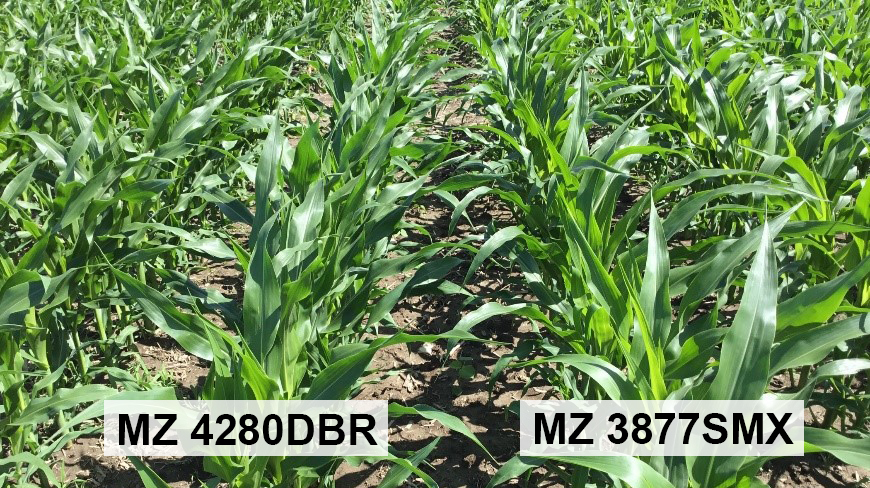Risk Management – How genetically diverse are your corn hybrids?
July 6, 2018Yield, Yield, Yield. Annually growers are challenged with producing as much yield as possible in the growing season available. Seasonal variation challenges growers’ strategies to maximize yield. Hybrid selection prior to planting can provide a risk management strategy with minimal cost to growers.
Yield is important however managing risk is equally important. In agriculture we are faced with the uncertainties of the upcoming season and despite crafting the most robust crop plans it is the environment that greatly influences how the season will unfold.
The genetic diversity of modern crops is often questioned as varieties have been increasingly bred for uniformity to foster modern farming practices. Growers strive to have all plants to emerge, grow, flower and mature at the same time to maximize efficiencies. Although there may not be genetic variation within a variety there is genetic variation among hybrids.
The diversity of corn is often underestimated. Humans have 20,000 genes grouped into 23 bundles or chromosomes and it these genes that influence how we look, behave and navigate life. In comparison, corn has 32,000 genes arranged over 10 chromosomes (Schnable et al.,2009). With 30% more genes than humans it would appear that corn plants would be more genetically diverse than humans.
Many growers are familiar with growing genetically diverse hybrids to manage insects. European corn borer was a major insect problem until the introduction of resistant hybrids. A stewardship requirement of growing these resistant hybrids was to grow a portion of acres with a different hybrid that was not resistant. By providing corn hybrids that were genetically different in their ability to control ECB, growers implemented a risk management strategy aimed at preventing the evolution of resistant insects This strategy is still implemented today in hybrids with integrated refuge (Figure 1).

Figure 1: Integrated refuge as an example of planting two genetically diverse hybrids to manage ECB. Canadian Pest Coalition, 2018
Stress at pollination is the largest environmental risk to corn production. Growers are encouraged to “spread out the maturity dates, which will spread out the timing of pollination and other key stages” when selecting hybrids (Licht, 2017). Hybrids that differing in relative maturity and pollination timing are common places to start. The challenge to growers is determining if the hybrids selected are related.
Modern breeding techniques coupled with global breeding programs has increased the genetic diversity of modern corn hybrids. Corn genetics from around the world are being incorporated into hybrids that we are growing today and will grow tomorrow. Increased genetic diversity provides growers with additional tools to manage environmental risk.
Growers can visually see the genetic diversity of hybrids within a few weeks after planting. Hybrids within any given maturity differ in plant colour, leaf orientation and growth habit. Genetic diversity in many cases is easier to see in the fall. Differences in ear characteristics, husk cover, stay green and harvest moistures continue to show the genetic diversity available to growers.

Figure 2: Genetic diversity in plant characteristics of two hybrids MZ 4280DBR and MZ 3877SMX.
Maizex Seeds takes pride in delivering high performance hybrids with the most elite genetics available. By the very nature in which hybrids are sourced and commercialized, Maizex Seeds offers the most genetically diverse corn offer in the industry.
Yield is the most important factor when growers consider which hybrid to grow in a given year. However, in agriculture we are challenged with the year to year variation in the growing season. Selecting hybrids that are genetically diverse offers growers peace of mind knowing that they have taken steps to manage environmental risk in their operation. Are growers choosing hybrids with enough genetic diversity? This is a good question for all growers to explore as they evaluate their current hybrid line-up and examine hybrid performance and hybrid options in the coming months.
References
Figure 1. Accessed June 24, 2018. Canadian Pest Coalition (https://www.cornpest.ca/ccpc-en/assets/Image/ECB%20Only(1).png)
Licht et al, 2009. A Guide to Choosing Corn Hybrids. Iowa State University Extension. October 9, 2017 Accessed June 24, 2018. (https://crops.extension.iastate.edu/cropnews/2017/10/guide-choosing-corn-hybrids)
Schnable et al, 2009. The B73 Maize Genome: Complexity, Diversity, and Dynamics. Science 20 Nov 2009:Vol. 326, Issue 5956, pp. 1112-1115
